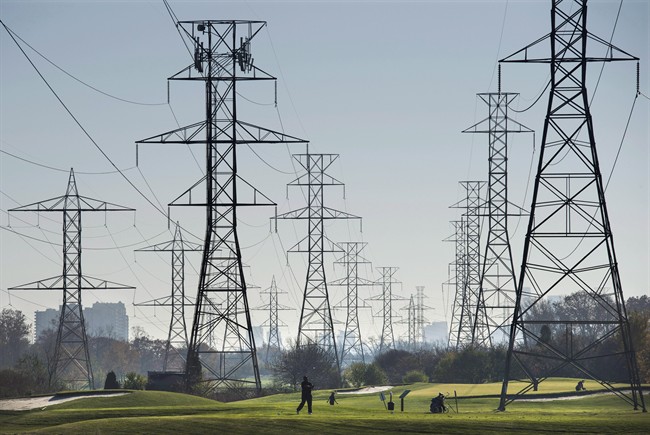Hydro customers in Ontario have exactly one month before utility providers in the province can once again cut off their power for non-payment.

With a May 1 deadline looming and more pressure than ever to keep customers connected, the province’s electricity regulator, the Ontario Energy Board, is urging customers to act quickly to avoid disconnection and manage any unpaid bills.
READ MORE: Ontario Energy Board orders utility companies to reconnect customers
In a document obtained by Global News and set for release in the coming days, the OEB is recommending customers follow five steps to keep their lights on this spring.
Step one: Know the rules
The OEB has special rules in place to ensure low-income customers are treated fairly.
These rules include waiving security deposits, a fee often charged to customers struggling with their electricity bills, allowing longer payback periods under arrears payment plans and offering a longer grace period to customers before being disconnected.
WATCH: What led to the new Ontario Liberal government plan for hydro-rate reduction

Know your rights: 10 things a utility company MUST do before cutting off your power
- Give at least 10 days’ notice before disconnecting a customer for non-payment.
- Give at least 60 days’ notice before disconnecting a customer with a doctor’s note that says disconnection could pose “significant adverse effects” to the physical health of anyone living in the home.
- Provide detailed information — on the disconnection notice itself — about emergency funding available through the Low-income Energy Assistance Program (LEAP).
- Suspend disconnection for 21 days for any customer who has applied to LEAP.
- Provide information on arrears payment plans and equal billing options.
- Provide information on low-income assistance programs like the Ontario Electricity Support Program.
- Make “reasonable efforts” to contact a customer in-person or by phone 48 hours before disconnection.
- Clearly identify on the disconnection notice any service charges or fees that could apply when a customer is reconnected.
- Provide customers with a copy of the fire safety notice prepared by the Office of the Fire Marshal, as well as any other relevant safety notices.
- A utility company cannot disconnect a customer with a smart meter based solely on an estimated bill.
Step two: Contact your utility provider
To benefit from many of these rules, customers must first contact their utility provider.
Once contacted, the OEB expects companies to work with customers to set up arrears payment plans families can afford and to facilitate enrolment in the province’s various energy assistance programs.
Here’s a list of all utility providers in Ontario.
Step three: Apply for financial support
While Premier Kathleen Wynne has promised the government will consider automatic enrolment for low-income customers in the province’s energy assistance programs, the OEB is still urging customers to visit their website and begin the various application processes.
READ MORE: Hydro crisis timeline: How did we get here and what comes next
The Ontario Electricity Support Program helps reduce hydro bills by providing an on-bill credit of $30 to $50 a month for eligible low-income households. Indigenous low-income customers, and those with special medical equipment, can receive additional supports of up to $75 a month through the program.
The Low-income Energy Assistance Program, or LEAP, provides once-a-year emergency funding to customers facing disconnection. Eligible customers receive up to $600 toward their bill, while all customers receive an additional 21-day grace period before disconnection once an application is received by LEAP.
WATCH: Ontario energy minister admits mistake with green energy program

Step four: Become more energy-efficient
Under the Liberal government’s new Fair Hydro Plan, which includes an additional 17 per cent reduction in electricity costs on top of the 8 per cent provincial HST rebate, eligible low-income customers can also receive support for energy-efficient products and appliances.
The saveONenergy Home Assistance Program provides homeowners and tenants with free LED lightbulbs, programmable thermostats and high-efficiency ceiling fans. Some customers may also be eligible to receive enhanced weatherproofing, more insulation and new appliances.
READ MORE: Premier Kathleen Wynne’s approval rating drops to all-time low of 12% in new poll
Low-income and northern residents may also qualify for several home improvement and energy tax credits. These can be claimed when filing your annual income tax return.
Step five: Contact the OEB
Electricity customers in Ontario have a right to contact the OEB.
If you believe your utility provider has not followed the rules correctly, or if you need more information, you can visit the OEB’s website or contact them by phone at 1-877-632-2727.
- Buzz kill? Gen Z less interested in coffee than older Canadians, survey shows
- ‘She gets to be 10’: Ontario child’s heart donated to girl the same age
- Canada updating sperm donor screening criteria for men who have sex with men
- Indigo nears privatization but experts warn turnaround won’t be ‘quick fix’




Comments